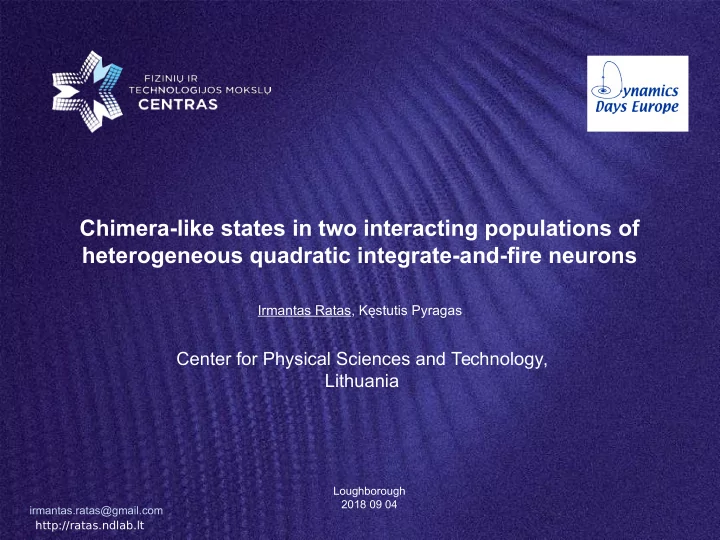

Chimera-like states in two interacting populations of heterogeneous quadratic integrate-and-fire neurons Irmantas Ratas, Kęstutis Pyragas Center for Physical Sciences and Technology, Lithuania Loughborough 2018 09 04 irmantas.ratas@gmail.com http://ratas.ndlab.lt
Overview •Single neuron •Single population of neurons – Macroscopic field equations – Bifurcations •Two interacting identical populations – Symmetric solutions – Non-symmetric solutions •Conclusions
Quadratic integrate-and-fire neurons Excitable Spiking Equations:
Quadratic integrate-and-fire neurons Excitable Spiking Equations: Theta representation
Interaction Neurons interact synaptically Modeled by Heaviside function Neuron effects other neurons only, when its potential exceed threshold value.
Macroscopic variables Microscopic model Macroscopic variables: ● Mean membrane potential ● Firing rate Infinite size network limit enables analytical approach.
Continuity equation Continuity density function: number of neurons between and . Continuity equation Trivial stationary solution:
Continuity equation Lorentzian ansatz E. Montbrio, D. Pazo, A. Roxin , Phys. Rev. X 5, 021028 (2015) - population firing rate - average potential distribution of parameter
Macroscopic equations If external currents are distributed according to Lorentz function with width and center . (Network consists both excitable and spiking neurons) Relation with Kuramoto order parameter:
Macroscopic equations If external currents are distributed according to Lorentz function with width and center Coupling strength Average potential Spiking rate
Network Identical populations 1st 2nd Network Network interactions internal external
Network Identical populations 1st 2nd Network Network interactions internal external Macroscopic equations:
Symmetric solutions Transverse and longitudinal coordinates: Symmetric solutions: Equations for Q and M are identical to eq. of a single population with a modified coupling strength J=J in +J ex (equilibrium points and limit cycles)
Symmetric solutions Transverse and longitudinal coordinates: Symmetric solutions: Equations for Q and M are identical to eq. of a single population with a modified coupling strength J=J in +J ex (equilibrium points and limit cycles)
Symmetric solutions Transverse and longitudinal coordinates: Symmetric solutions: Equations for Q and M are identical to eq. of a single population with a modified coupling strength J=J in +J ex (equilibrium points and limit cycles) stationary points limit cycles
Non-symmetric solutions Macroscopic equations:
Non-symmetric solutions Chimera-like Chaotic Splay state
Non-symmetric solutions Chimera-like state for external excitatory coupling
Conclusions Competition of neural interactions within and between the populations may lead to a rich variety of nonsymetrical patterns, including splay state, antiphase periodic oscillations, chimera like states and chaotic oscillations as well as bistabilities between them. I. Ratas and K. Pyrgas, Symmetry breaking in two interacting populations of quadratic integrate-and-fire neurons , Phys. Rev. E 96, 042212 (2017). I. Ratas and K. Pyragas, Macroscopic self-oscillations and aging transition in a network of synaptically coupled quadratic integrate-and-fire neurons , Phys. Rev. E 94, 032215 (2016).
ACKNOWLEDGMENT This work was supported by Grant No. S-MIP-17-55 of the Research Council of Lithuania
Recommend
More recommend